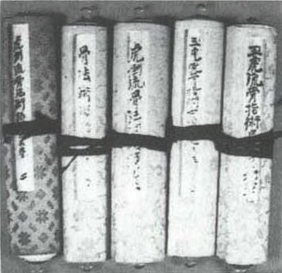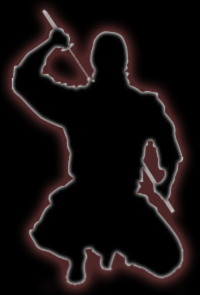Takagi Yoshin Ryu Jutaijutsu
(Named After Shigenobu Takagi)

HATSUMI SENSEI is the 17th SOKE of the TAKAGI YOSHIN RYU
Lessons are held every Wednesday from 20.00 till 21.30 and every Saturday from 10:30am to 12:00the Bujinkan Malta Dojo by Alfred Galea 15th Dan
Introduction of Takagi Yoshin Ryu
Takagi Yoshin ryu compared to the other schools in the Bujinkan, has very few similarities, as do the other schools. The Dai Nihon Bugei Ryu Ha says that a series of techniques which were in the future years to become known as the Takagi Ryu, were put together by a wandering Toaist monk called Sounryu in 1569. He lived in Rikuzen Funagawa not far from Sanroku mountain. Takagi ryu techniques were made up from Taijutsu, Bojutsu, and Shuriken. The school passed on to Umannosuke Shigetada Takagi. Umannosuke started to study under Oriuemon in 1671 when he too was 16, adding many new techniques from the Jujutsu school Takauchi Ryu. He however taught the school as Takagi Ryu Dakentaijutsu, Bojutsu, Sojutsu, Naginatajutsu, and Senban Nage. In 1695 he was recognised by the Emperor as a high class martial artist. He died 26 April 1711.
Gennoshin Higeshige was the son of Umannosuke and changed the name to Takagi Yoshin Ryu Jutaijutsu. He taught in Hyogo prefecture. Ohukuni Shigenobu was an expert in Kukishinden Ryu, he was invited to stay and teach his system to the Takagi Yoshin Ryu by Gennoshin. Gennoshin became ill and died on 2nd October 1746. He asked Ohkuni to continue the original teachings in the new way that they had created together. Ohkuni then renamed the school Hon Tai Takagi Yoshin Ryu.

Ishitani taught Takamatsu Toshitsugu from 1903-1911.
In the past these techniques were used in battle where Samurai would be wearing armour and punches and kicks would have little effect. Therefore it is more effective for the opponent to be dropped or dragged down by their own body weight.
Training in the Takagi Yoshin Ryu is as follows:-
Breakfalls, blocks , and counterstrikes. These also included holds and releases.
Followed by levels of
- SHODEN NO GATA
- CHUDEN NO SABAKI GATA
- CHUDEN NO TAI NO GATA
- OKUDEN NO GATA
- ERI SHIMEGATA
- MOGURI GATA
Following these there are techniques for dealing with armed attackers.
Takagi Yoshin Ryu has a variety of ways for taking down an attacker which include nerve points, chokes, kicking the legs away, and throws.
Characteristics
Most famous in the Bujinkan as a "Bodyguard School" with fast and effective jujutsu techniques, and daishosabaki (jujutsu while wearing both swords in the belt). Other techniques are based around bojutsu.
It has been mixed with sumo techniques, Takenouchi Ryu jujutsu and others.
Takagi Yoshin Ryu has been handed down together with Kukishinden Ryu for generations.
The Takagi Yoshin Ryu uses many techniques that appear similar to judo or aikido, but goes further in that when the techniques are applied it's made difficult for the opponent to escape by rolling or breakfalling.
These are very close quarter techniques with the opponent held close - a result of the techniques being developed in buildings.
Students are taught to use speed, look the opponent in the eyes and use their impulse and weight.
Also translated as "Heart of the Willow Tree School".
History
According to the DAI NIHON BUGAI RYU HA, the techniques and ideas that would evolve into TAKAGI - RYU were organised by a man known as Sounryu in the year 1569. Sounryu lived in Rikuzen - Funagawa near Sanroku mountain. Not much is known about Sounryu, but there is reason to believe that he may have been a wandering Taoist sage. In the beginning, the ryu contained the techniques of taijutsu, bojutsu and shuriken jutsu. This may be a more symbolic historical notion than an accurate description as it is widely accepted by japanese martial art scholars that man's first fighting arts consisted of unarmed tactics, fighting with sticks of various lengths and hurling stones. It should be noted that the original Shaolin temple taught a fighting art that was famed for its use of the very same elements.
The techinques of the system passed through a couple of generations where it finally came to be headed by Oriemon Shigenobu Takagi. Takagi is considered the founder of the actual system, thus the ryu still carries his name.
Oriemom did much to put Takagi - ryu on the map. He successfully concluded a number of practice matches with the Yagyu - ryu (who, at the time (ca. 1600), were the instructors to the Shogun, ie the Tokugawa family). In addition, Oriemon further refined the system.
Later he passed the leadership of the ryu to Umannosuke Shigetada Takagi. Umannosuke took the development of the ryu even further by adding elements of the Takauchi style of Jujutsu and the Zen school of thought that he was exposed to while training with the monk Gudo - Washo of the Chuzan temple. By the end of his life, Umannosuke had travelled and taught widely, thus the Takagi - ryu came to be passed down to the present day in number of forms. The form practiced within the Bujinkan style of Ninjutsu stems from the teachings of one Yagi Jigero Hisayashi who founded the Takagi Yoshin ryu four generations ago.

The actual structure of the Takagi Yoshin - ryu is of interest. It should be noted that one of the trademarks of Jutaijutsu (as opposed to Judo or Aikido) is that the techinques are delivered in such a way as to make the opponents receiving skills (breakfalls, rolls, etc) very difficult for him to execute. This is important because many of Takagi - ryu's techniques go back to a time when armour was worn and standard punches and kicks did not have much effect on the recipients.
The curriculum of Takagi Yoshin - ryu jutaijutsu has a number of levels. Such as basic skills as breakfalls, blocks, counter strikes and hold releases are covered in the Kihon Waza (basic techniques). After the Kihon, there are another six major areas of concentration. These are Shoden no gata, Chuden no sabaki gata, Chuden no tai gata, Okuden no gata, Eri shime gata and Moguri gata.
There is an additional set of techniques specifically designed for dealing with weapons while unarmed and a number of techniques with which to counter all of the techniques in the sections named above. Each of these sections of the Takagi - ryu's curriculum has a number of lessons to offer the martial artist and just learning the basic forms of each technique is really only the beginning.
A number of techniques within the system are worthy of note as they stand out in terms of combative application. Various ways of taking an opponent down using surprise attacks (kicking his legs out from under him), using various pain holds and chokes (itami jime) to simple grabbing attacks combined with nerve strikes and throws (iki chigae) in some techniques, the idea of a quick drop to the ground to throw an opponent or counter a throw is employed. Often these throws are executed by dropping to one knee and dragging the opponent down with the weight of ones own body. Of course, Takagi Yoshin - ryu is far too complex to cover in a simple article, however, this introduction to the ryu's history and techniques may spur further interest in an art which has influenced the fighting style of many as well as Ninjutsu practitoner.

Kotsu
1. There are no set kamae in Takagi Yoshin Ryu. Due to the connections with the Kukishinden Ryu, Hira, and Seigan can be used.
2. When in Seiza the toes are up and the back is straight. the hands rest on the tops of the thighs.
3. When striking in Takagi Yoshin Ryu, a Kiai is given out.
4. When the collar is grabbed, grab your own jacket below Ukes hand and press the thumb into the pressure point of the little or ring finger.
5. To release a collar grab, grab Ukes wrist and pull his hand and your jacket apart with a violent pull. Turn the body to face the hands at the same time.
6. The take downs in practice are done gently. For real they are done so that Uke cannot roll, breakfall or escape. They are designed so that he breaks his back, neck and or a limb. The restraints are for holding down a violent attacker.
7. When a strike has been applied, a further strike is sometimes applied to make sure This is either done straight away, or at a later time during the technique.
8. When striking from Seiza(e.g), the right knee comes up and the left comes across the back, at 90 degrees to the right foot. The toes are up.